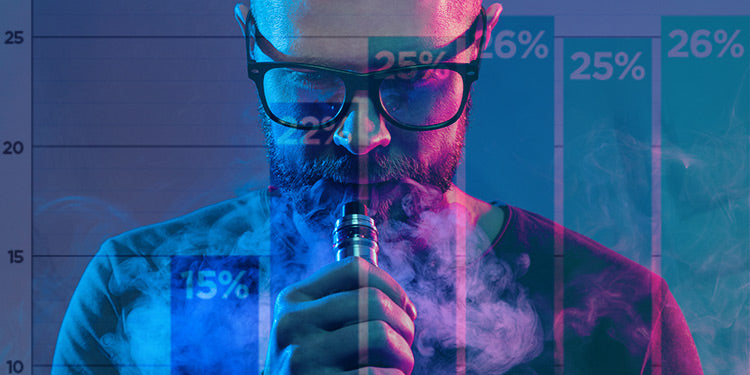
The Story of Vaping in Numbers
From a small niche market in the late 2010s, vaping has rapidly changed the face of nicotine and tobacco in the world, gaining over 40 million users worldwide by 2018.
However, it has gained some powerful enemies in the process.
In this post, we’ll be soaring over the superlatives and hyperbole present in the vaping debate, and looking at the story that numbers and data tell us.
Who vapes?
Data from the UK shows that the majority of vapers are now either ex-smokers or smokers.

Source: Action on Smoking and Health
Is vaping a gateway to smoking?
World Health Organization data from 2019 shows a decline of 60 million smokers since 2012.
In England, which has one of the most liberal attitudes towards vaping, we can chart the fall in smoking rates against the increase in vaping rates.
The Rise of Vaping v. The Decline in Smoking

Sources: Action on Smoking and Health, UK Gov, NHS
But that graph only captures people who are still vaping - according to ASH there are now 2.2 million ex-smokers in the UK who have tried vaping but have now quit both vaping and smoking.
Source: Action on Smoking and Health
Perception of vaping and nicotine
Ninety percent of the public regard nicotine, as an individual substance, as more harmful than caffeine, according to the Royal Society for Public Health.
Perceptions of vaping have also changed, as data from Action on Smoking and Health shows, with more people believing that vaping is as harmful or worse than smoking.

Source: Action on Smoking and Health
The data lead to Deborah Arnott, head of ASH UK, to state:
“Vaping has helped many thousands of smokers quit to date. But many thousands more could benefit if they were not put off by the persistent, worsening and inaccurate beliefs the public hold about vaping.”
Powerful Anti-Vaping Campaign
A major reason for the change in perceptions is a well-organised and financed campaign against vaping. We shouldn’t be surprised - vaping is a disruptive industry which threatens $250 billion dollars in tax, billions in tax settlements to US states and sales of both tobacco and pharmaceutical products.
This has lead to millions of dollars being channelled into an anti-vaping campaign. One source alone, Bloomberg, has spent $160,000,000 on an anti-vaping campaign. Bloomberg activities have included (but are not limited to):
- funding anti-vaping campaign and paying for the WHO report on tobacco (which is anti-vaping)
- paying moms to tweet anti-vaping messages
- paying TV ads in the states
- funding a UK documentary on vaping and Heat Not Burn.
Vaping could determine the US election
In many US states, there are more vapers than the 2016 electoral margin.
For example, Trump won Florida by less than 113,000 votes. The state has 900,000 vapers.
73% of vapers said they would be less likely to vote for a politician who supports strict regulations on vaping.

The data may be a big reason for Trump reversing course on a vape flavour ban.
Source: ATR
Youth Vaping
Anti-vape organisations have highlighted the danger that vaping could lead to an increase in smoking rates.
That’s despite the fact that since vaping has been introduced, there has been a massive fall in youth smoking rates.
While there has been an increase in experimentation, regular use has remained low and vaping is mostly used by children who are current smokers.

Unfortunately, a well-funded campaign against youth vaping may be inadvertently raising youth vaping rates.
The future…
Vaping grew exponentially in early years, but recent growth has been hit by well-funded, organised opposition.
The ability of vaping to survive will depend on the willingness of vapers to advocate and the continuing dedication of researchers and public health to fight against misperceptions.